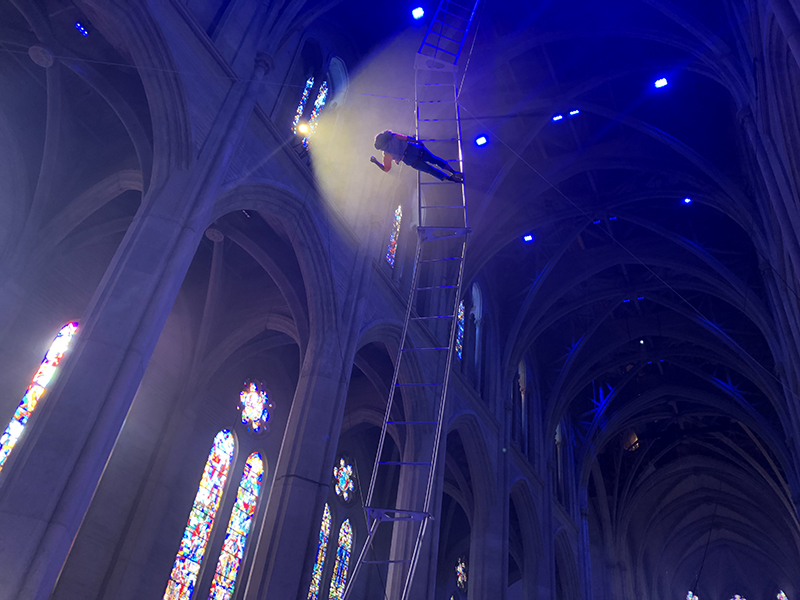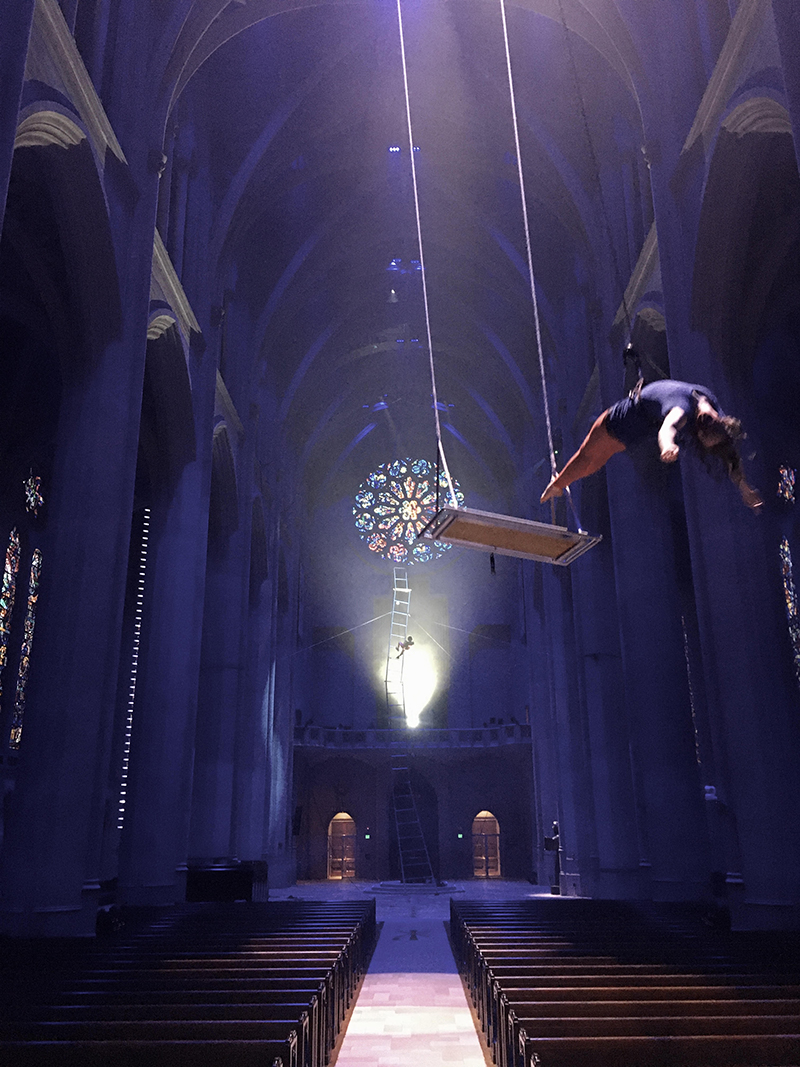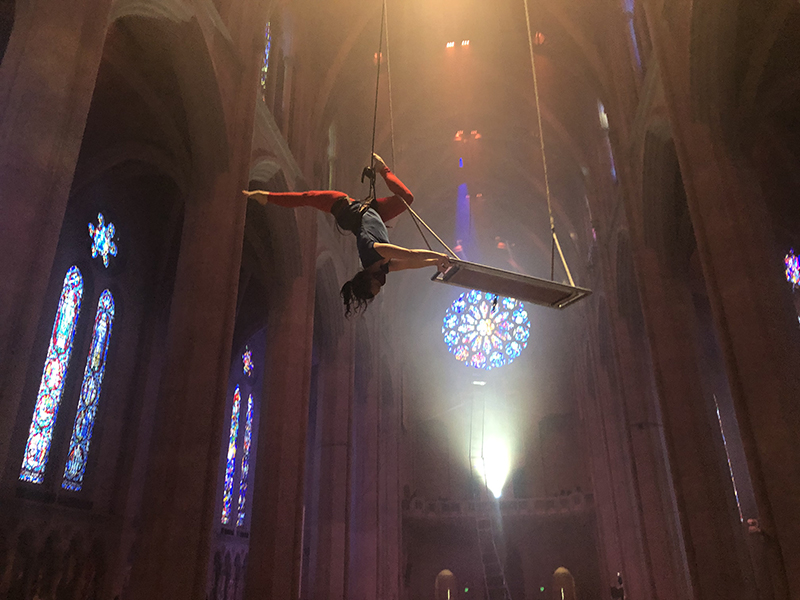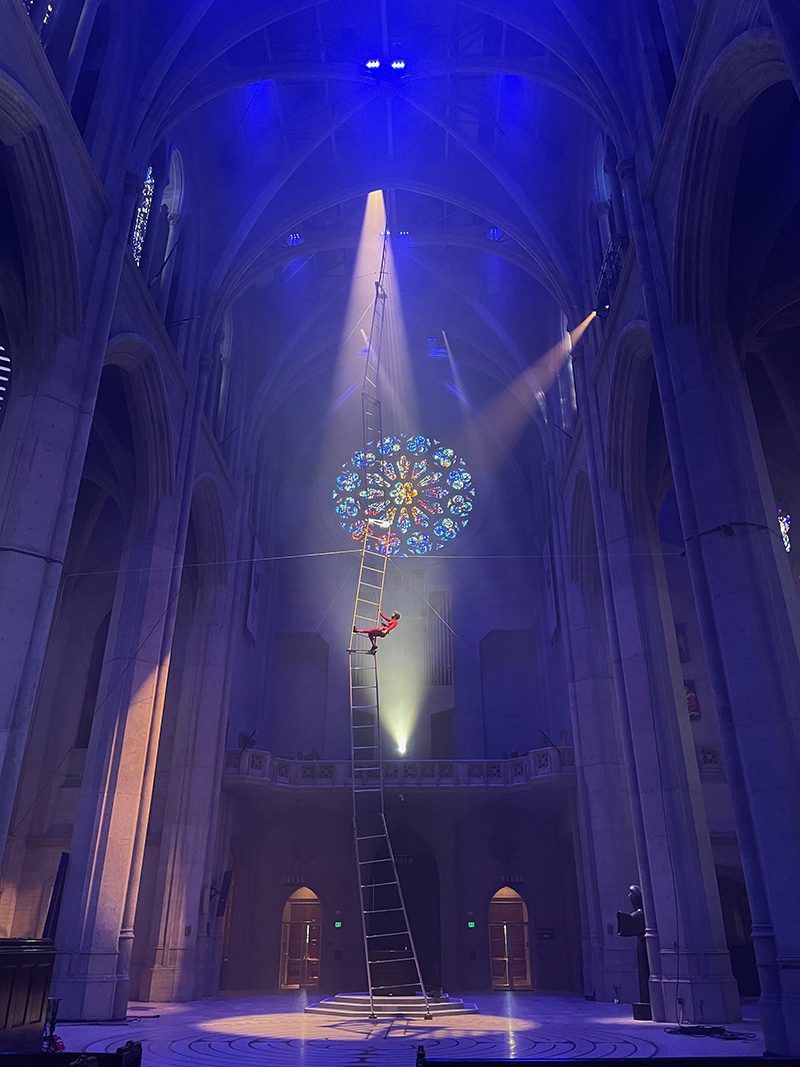A Study of Surrender
An interview with Zaccho Dance Theatre artists Veronica Blair, Ciarra D’Onofrio, Suzanne Gallo, Saharla Vetsch, and Helen Wicks
Zaccho Dance Theatre is a Bay Area site-specific aerial dance company directed by Joanna Haigood that has been making work on culturally significant subject matter since 1980. In February, the company will premier Love, a state of grace at Grace Cathedral in San Francisco. Here, Zaccho Dance Theatre artists Veronica Blair, Ciarra D’Onofrio, Suzanne Gallo, Saharla Vetsch, and Helen Wicks share how the piece is a spiritual study of surrender, as well as how the apparatuses they dance on augment the meditative quality of the work.
Love, a state of grace will premiere on February 11, 12, 17, and 18 at San Francisco’s Grace Cathedral. For more info, visit zacchograce.brownpapertickets.com.

Pictured: Zaccho Dance Theatre aerialist Clarissa Dyas at Grace Cathedral
Photo courtesy of Zaccho Dance Theatre
~~
Can you each share a little about your dance history and how you came to perform with Zaccho Dance Theatre?
Veronica: I’m an aerialist and I perform mainly in circus companies, theme parks, and most recently cruise ships. I also work with Troupe Vertigo in Los Angeles, which is a mix of dance, circus, and theater. I love aerial work and am always look for ways to challenge myself. Zaccho provides a place for me to do so. I began working with Zaccho in 2016 at the San Francisco Aerial Arts Festival where I did an aerial straps number, which includes lots of tricks. I performed the piece to spoken word, which transformed it. From there, I cultivated a piece that addressed trauma with suitcases on the aerial silks. Working with Zaccho, I’ve been challenged as an athlete and as an artist. I’m glad to have Zaccho be my home.
Helen: I have been seeking flights and finding acrobatics since I was three. My training in my youth was in artistic gymnastics where I trained on the US national team as a pre-teen. From there I moved into dance and the joy and expression of movement. I majored in Dance at Bard College. I was influenced by Bill T Jones, Merce Cunningham, Trisha Brown, and other major modern dance choreographers. I met Joanna Haigood in a serendipitous way at Camp Winnarainbow, a circus camp in Laytonville. I have been working with her since 2014, finding intersections of identity, race, apparatus-based inventions, and music. I have much love and gratitude to Joanna and the community she brings together. I also run my own company, Helen Wicks Works, that is circus-informed aerial dance combining contemporary dance and acrobatics.
Saharla: I came into the arts through theater and musical theater. I found dance in high school and went on to major in Dance in college. Movement alone was more interesting than a play or musical with just a little dance. I’ve always been a physical and robust mover interested in the physical boundaries of the body and how they can be pushed. I only started doing aerial dance recently in the past few months. I feel invigorated; it feels like starting to dance all over again because the work is so different. The way I orient my body and think about space has drastically changed from dancing on the floor. I’m finding joy in the effort.
Ciarra: I took my first aerial class when I was five at the Bolinas Community Center. I met Joanna as another Bolinas community member some years later. I did modern dance, contemporary, and jazz as I grew up. I did theater as a kid, but as soon as I found dance, I knew it was where it was at. I transitioned to circus and aerial through Camp Winnarainbow, where I still go every summer to teach. It’s been a huge part of my development as an aerialist. I’m drawn to Joanna’s work at Zaccho because it uses art as personal discovery, community building, and storytelling. It’s such a beautiful way to express myself and explore critical ideas. I’ve been teaching at Zaccho for four years. This is my first show with Zaccho, and I worked with Joanna on the research for the show.

Zaccho Dance Theatre aerialists Helen Wicks (front) and Ciarra D’Onofrio (back) at Grace Cathedral
Photo courtesy of Zaccho Dance Theatre
Suzanne: I found dance as a small child and it centered me, as it centers me to this day. I have deep roots in dance, though now I have been doing vertical dance longer than I danced on the ground. I have a long history of ballet in my life and I danced with a lot of ballet companies – Ballet Met, Atlanta Ballet, Ballet West, San Francisco Opera, Lines – and then I started exploring pickup work. I did some work with ODC and other local artists. A friend of mine, Mary Carbonara, introduced me to Amelia Rudolph, who was the founder of BANDALOOP, another aerial dance company. Amelia was looking for some dancers. At the time, climbing gym culture was about to take off. With the development of climbing gear, suddenly the movement possibilities changed. You could move your arms without holding the rope.
I’ve done quite a bit of work with BANDALOOP. Now I’m the youth program director. I also work with Destiny Arts teen program. I met Joanna back in the day through a friend. During the time, I was beginning to explore my own work. What we have in our toolkit informs everything we do on the ground and in the air. I started as a terrestrial dancer and have studied many different disciplines. They all live inside of me.
Can you share more about Zaccho’s upcoming performance, Love, a state of grace? What does the piece mean to each of you?
Ciarra: The piece was originally about the history of violence in sacred spaces. Most of our research focused on bombings and shootings in churches, synagogues, and mosques. Through conversations with Joanna, my understanding is that a lot of what was coming up in the research was the responses to the violence and the community healing that happens after. Joanna was focused on this theme of love. COVID happened, and that shifted the work. Throughout the pandemic, the piece began to focus more on how love gets us through difficult times.
Veronica: I feel the piece as a “come to Jesus” moment. What would be the process of choosing to believe in something bigger than ourselves? I’m not necessarily referring to religion, but the act of choosing to surrender to nature and a higher sense of self and of being connected with others. There are elements of surrender in the piece: this big beautiful swing we use, a 100-foot tall ladder that reminds me of Jacob’s Ladder, a quieting meditation area we call tensegrity which will be a plexiglass platform that people can walk under and where our movements above are as if we’re creating a mandala. So there are many different elements of the show and they speak to me in a way that expresses the ultimate surrender, letting go of frivolous thoughts and processes that are ingrained and that we live under.
Helen: For me, this work is about the relationship between discipline, love, and the role of surrender. I let go of my religious upbringing because of my physical practice; the discipline of my physical practice took over. I was conscious of that, but it became clearer during the residency we had last January. Through the practice of acrobatics and dance, I surrendered to the need for air, process, and ongoing training. I physically feel surrender when I dance on the 70-foot swing in the piece. In terms of love and spirituality, surrender is present. It’s something I practice accessing while flying on the swing.

Pictured: Zaccho Dance Theatre aerialist Helen Wicks at Grace Cathedral
Photo courtesy of Zaccho Dance Theatre
Suzanne: Love occupies big spaces and has many interpretations. On that swing, there is definitely surrender. I concur with Helen that dance is my spiritual practice. There’s no separation. I am my most pure in moments of dance.
Saharla: While practicing on the ladder, I’ve been thinking of it as a labor of love. Working with this new object in this new way is very complex, but in its purest form it is a labor of love.
What has been the choreographic process?
Helen: The performance was originally supposed to be in August 2020, and then it was rescheduled for January 2021, which didn’t happen either, but we were able to rehearse in Grace Cathedral that month as a residency, pre-vaccines but masked up. We rotated between the different stations – the swing, the ladder, and tensegrity – getting comfortable with the height and the totality of the space. It was a big test for the riggers. They are working real magic making this piece possible.
Suzanne: Sometimes they played the organ during the residency, and it made the rehearsals very spiritual. Because we’re inside a cathedral, the organ music permeates the whole body.
Veronica: The show will feature organ music. Audience members will experience the vibrations hollowing the space and clearing the mind. For me, the music encourages humility and not getting into technicalities.
Ciarra: Rehearsing in the cathedral was unlike anything I’d done before. The calm and quite while playing on the ladder and looking up at an enormous stain glass rose was awe-inspiring. It was unavoidable that it would be a spiritual experience for myself and others.

Zaccho Dance Theatre aerialist Ciarra D’Onofrio at Grace Cathedral
Photo courtesy of Zaccho Dance Theatre
My understanding is that Love, a state of grace is partly a response to the pandemic and social uprisings of the past two years. Has aerial dance as a field had a reckoning in terms of awareness about race and gender like other areas of the dance world?
Veronica: In general, the Bay Area has been pretty inclusive. I got my start here as an aerialist. I’ve studied in France, Florida, and South Africa when I was with the circus, but in terms of my development as an artist and finding my voice in the medium, a lot of that has happened in San Francisco. Nationally within the circus community, there has been an awakening, sometimes rude, to the point that people are now actively looking to hire BIPOC performers. I’ve been having a lot of conversations with producers and directors about how things have been in the past and the direction they would like to move their company or studio. I do find myself playing more of the protagonist and main character roles, whereas two or three years ago that would never happen. You do see more people of African descent playing lead roles in media and entertainment. A radical awaking is happening with regards to representation, and the circus community is experiencing a shift in thought. I think five to 10 years from now it will be quite different.
Helen: In my experience, Joanna has been making work about race, culture, and gender, and asking hard questions from a historical perspective as long as I’ve known her. Joanna’s ongoing work to connect Bayview/Hunters Point community and youth to aerial arts at Zaccho is incredible and inspiring.
What do you hope audiences take aware from Love, a state of grace?
Veronica: I hope that people take away a bit of hope. Not hope in a generic way but hope in humanity by seeing our bodies articulate this beautiful cathedral space. When we work on ourselves and raise our vibration, that affects others, even people we don’t know. I hope people feel hope within themselves and within others.
Saharla: I hope people experience empathy. Empathy creates understanding. I hope people feel a generosity of spirit.
Suzanne: Doing site responding work, the whole proscenium stage is gone. We’re sharing time and space with the audience, which has a greater depth. Love is infinitesimal and encompasses many things. Sometimes it’s vulnerable and hurts to love deeply. Surrendering to that love is what I hope people take away.
Helen: To the pain that exists with love, resilience is something I hope audiences can access or feel in some way, especially going on years of this pandemic.
Ciarra: My hope is that people get a taste of that surrender we’re feeling. With the choir and organs as well as the interaction of sharing the space, the audience is part of the spiritual experience. Especially after this pandemic when we’ve been so separated, I hope people feel connection and a sense of community. What is so powerful is that the audience will be moving throughout the space during the show. This installation style performance invites the audience members to become part of the performance, ritual, and spiritual experience that we are all creating together. This coming together as a collective and community to build a space of healing and love is especially powerful after two years of social isolation.
Any other thoughts:
Veronica: We need art, and we need people to experience art. People need to be engaged and energized by the prospect of live performance. It is kinetic. It is the oldest way, from storytelling around a fire, to instrumentation, dance, and acting, it is how we connect to people in large groups. It’s a healing modality; we can use it to heal people and share inspiration. However it’s received, it’s much needed now.
~~
To learn more about Zaccho Dance Theatre, visit www.zaccho.org.
To learn more about Love, a state of grace, visit www.zaccho.org/love_about.
